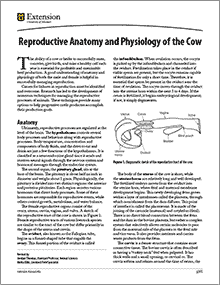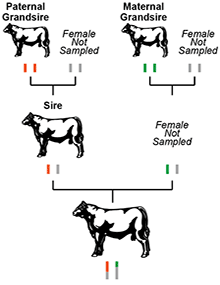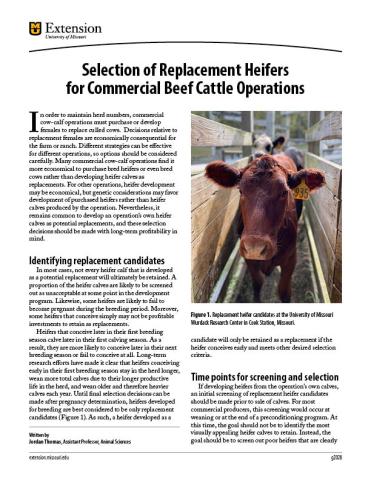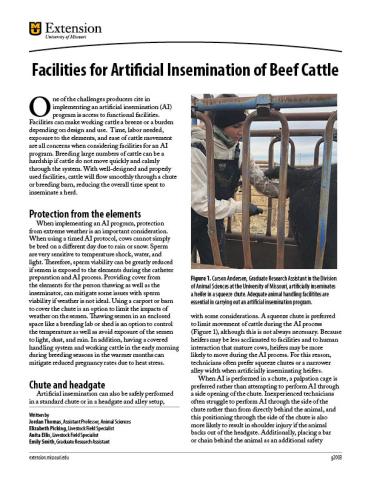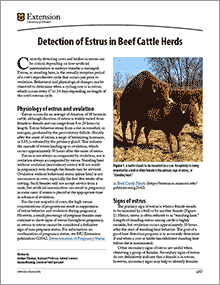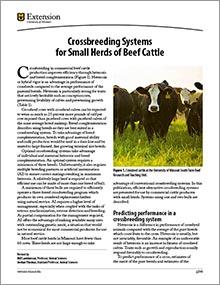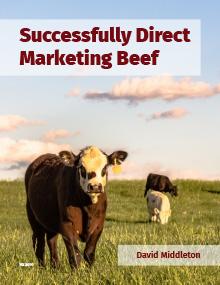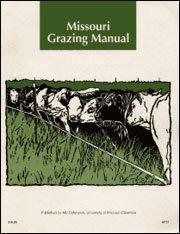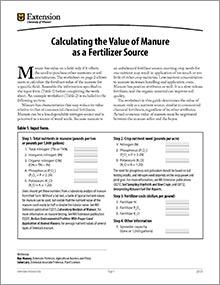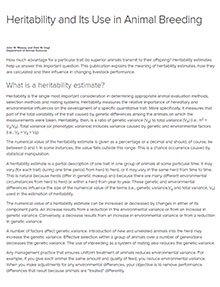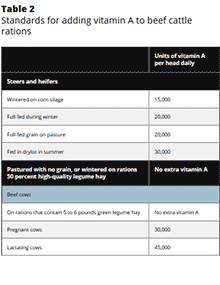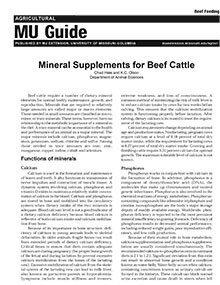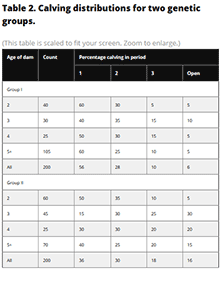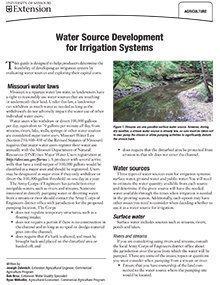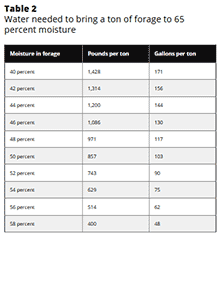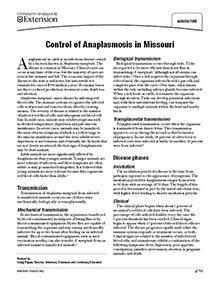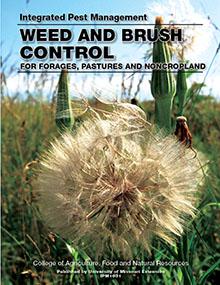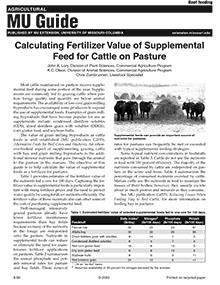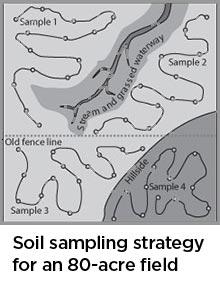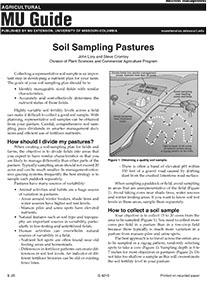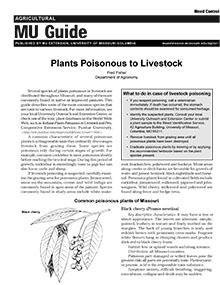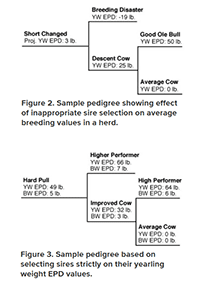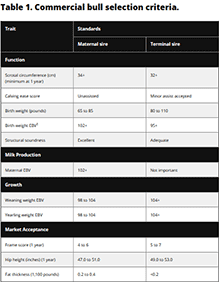The following publications cover topics related to Beef Extension. For a complete list of MU Extension publications, visit the main Publications page.
Reproductive Anatomy and Physiology of the Cow
Revised
The ability of a cow or heifer to successfully mate, conceive, give birth, and raise a healthy calf each year is essential for profitable and sustainable beef production. A good understanding of anatomy and physiology of both the male and female is helpful in successfully managing reproduction.
The Random Shuffle of Genes: Putting the E in EPD
Reviewed
Understanding EPD variability: how genetic shuffling during reproduction leads to differences among full siblings in cattle.
Selection of Replacement Heifers for Commercial Beef Cattle Operations
New
To maintain herd numbers, commercial cow-calf operations must buy or develop females to replace culled cows. Learn about different strategies so you can make the most economical decision for your farm or ranch with long-term profitability in mind.
Facilities for Artificial Insemination of Beef Cattle
New
Access to functional artificial insemination (AI) facilities is a challenge for beef cattle producers. Learn what to look for in an AI facility and view a list of portable breeding barns available through University of Missouri Extension.
Detection of Estrus in Beef Cattle Herds
New
Correctly detecting cows and heifers in estrus can be critical for beef producers. Learn behavioral and physiological changes that indicate standing heat, how to use estrus detection aids and how to time artificial insemination in this MU Extension guide.
Production Records for Commercial Cow-Calf Operations
New
Track key metrics like breeding, calving, and weaning to enhance cow-calf herd productivity and profitability through effective record-keeping.
Crossbreeding Systems for Small Herds of Beef Cattle
Revised
Crossbreeding in commercial beef cattle production improves efficiency through heterosis and breed complementation.
Successfully Direct Marketing Beef
New
Get tips on direct marketing beef in this 32-page publication.
Missouri Grazing Manual
Reviewed $20
Learn how soil, forages and animals interact in grazing systems, and get ideas for improving pasture quality and extending the grazing season for beef or dairy.
Calculating the Value of Manure as a Fertilizer Source
Revised
Use this worksheet to estimate the value of manure nutrients (nitrogen, phosphorus, potassium) and gauge how much manure to apply to corn, wheat, soybeans.
Missouri Frost/Freeze Probabilities Guide
Reviewed
Where in Missouri you live can make a big difference on when to expect your first or last frost. See this guide for probabilities based on past years.
Heritability and Its Use in Animal Breeding
Reviewed
Heritability has a large influence on livestock performance. Visit our website to learn about Heritability and Its Use in Animal Breeding.
Vitamins for Beef Cattle
Reviewed
Ensure beef cattle health by understanding the roles and requirements of vitamins A, D, and E, including deficiency signs and dietary sources.
Mineral Supplements for Beef Cattle
Reviewed
Beef cattle require a number of dietary mineral elements to remain healthy. Visit our site to learn about Mineral Supplements for Beef Cattle.
The System Concept of Beef Production: BIF Fact Sheet
Reviewed
The systems concept of beef production incorporates an awareness that there is more to consider in a beef cattle enterprise than simply the level of production. What is most important is the overall efficiency of the enterprise.
Water Source Development for Irrigation Systems
Revised
This guide helps producers assess irrigation feasibility by evaluating water sources, legal considerations, and estimating storage needs.
Wheat Silage for Beef Cattle
Reviewed
Learn how to effectively use wheat silage for beef cattle, including optimal harvest timing and moisture levels for improved feed quality.
Control of Anaplasmosis in Missouri
Revised
Learn how anaplasmosis affects cattle, how it's spread, and ways to manage and prevent this disease to reduce herd loss and economic damage.
Weed and Brush Control for Forages, Pastures and Noncropland
New $41
Annual broadleaf and grass weeds can become a serious problem in pastures and forages. Learn about forage crop, soil and weed problems in Missouri. See color photos of weeds at different stages and select herbicides with the help of tables in this manual.
Calculating Fertilizer Value of Supplemental Feed for Cattle on Pasture
New
Learn how supplemental feeds' nutrients benefit pastures, potentially reducing fertilizer costs.
Soil Sampling Hayfields and Row Crops
New
Collecting a representative soil sample is an important step in developing a nutrient plan for your farm. Make smarter management decisions and more efficient use of fertilizer nutrients by learning how to plan and take soil samples from your fields in th
Soil Sampling Pastures
New
Collecting a representative soil sample is an important step in developing a nutrient plan for your farm. The goals of your soil sampling plan should be to
Plants Poisonous to Livestock
Reviewed
Guide to identifying common Missouri plants toxic to livestock, including symptoms and habitats.
Understanding and Using Sire Summaries: BIF Fact Sheet
Reviewed
Learn how to effectively use sire summaries to make informed breeding decisions, enhancing herd genetics and productivity.
Using Performance Data in Judging Classes: BIF Fact Sheet
Reviewed
Judging contests are an important educational tool. Someday young cattle producers will be faced with selection decisions that affect the profitability of their operations. This guide can be used to train youth interested in modern beef selection practices.1
